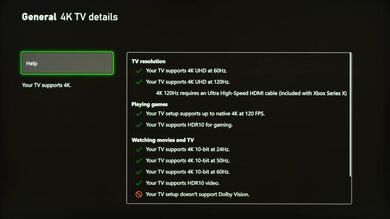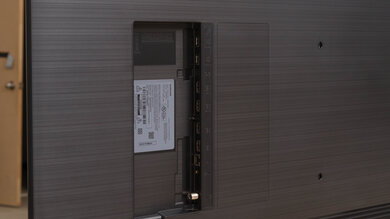The Samsung Q70/Q70A QLED is the mid-range model in Samsung’s 2021 4k QLED lineup, sitting between the Samsung Q60/Q60A QLED and the Samsung Q80/Q80A QLED. It competes with other mid-range models like the Sony X85J, the LG NANO90 2021, and the Hisense U7G. It has features that are usually included with higher-end models, like its HDMI 2.1 bandwidth, 120Hz panel, and variable refresh rate (VRR) support. However, it also lacks some important features like local dimming, and in Samsung's case, the 'Ultra Viewing Angle' technology. Still, it's a well-rounded TV that comes with the easy-to-use Tizen OS as its smart platform.
Our Verdict
The Samsung Q7 Series is a great TV for most uses. Thanks to its high contrast ratio, it looks excellent in a dark room, with deep blacks and no distracting blooming around bright highlights. It's also good for watching shows and sports in well-lit rooms, as it gets bright enough to overcome glare. Its fast response time delivers smooth motion in content like sports and video games, and its low input lag makes it feel responsive when gaming or using it as a PC monitor. HDR looks good, but it doesn't get bright enough to bring out the brightest highlights, and it lacks a local dimming feature to improve the contrast.
- Very good contrast.
- Bright enough to overcome glare.
- Impressive response time delivers smooth motion.
- No local dimming.
- Image fades and looks washed out as you move off-center.
The Samsung Q70A is good for watching TV shows in a bright room. Although it has only decent reflection handling, it gets bright enough to overcome moderate amounts of glare in a bright room, so visibility isn't an issue. It upscales cable TV channels and older shows on DVD well, and the built-in Tizen OS has a great selection of streaming apps, so you can quickly find your favorite shows. Unfortunately, it has a narrow viewing angle, so it's not ideal for a wide seating arrangement or if you like to move around with the TV on, as the image fades and looks washed out at an angle.
- Bright enough to overcome glare.
- Apps and interface run smoothly.
- Image fades and looks washed out as you move off-center.
The Samsung Q70A is good for watching sports in a bright room. It has an impressive response time, so motion looks smooth with fast-moving balls or players. It gets bright enough to overcome glare in most rooms, and it also has decent reflection handling, so glare isn't an issue overall. That said, it has a narrow viewing angle, so it's not ideal if you want to watch the game with a big group, as the image fades and looks washed out at an angle. It also has uniformity issues with some distracting dirty screen effect in the center.
- Bright enough to overcome glare.
- Impressive response time delivers smooth motion.
- Image fades and looks washed out as you move off-center.
The Samsung Q70A is an excellent TV for playing video games. Its impressive response time delivers a clear image with minimal motion blur or ghosting behind fast-moving objects, and it has an incredibly low input lag. It supports FreeSync variable refresh rate (VRR) technology to reduce screen tearing. Also, it supports 4k @ 120Hz games without issues, but only on one port, which is disappointing if you have more than one new-gen console.
- Supports FreeSync VRR.
- Impressive response time delivers smooth motion.
- Low input lag.
- No local dimming.
- HDMI 2.1 bandwidth on only one port.
The Samsung Q70A TV is great for watching movies in HDR. It's helped by its high contrast ratio, delivering deep blacks and bright highlights with no blooming, but it lacks a local dimming feature to improve the dynamic range. It displays a wide color gamut for HDR, so HDR content is vivid and realistic, but its HDR brightness is a bit limited, so the brightest highlights don't quite pop as well as they should.
- Very good contrast.
- Removes 24p judder from all sources.
- Displays wide color gamut.
- No local dimming.
- Stutter with low frame rate content.
- Not quite bright enough to make highlights pop.
The Samsung Q7DA is great for HDR gaming. The fast response time, low input lag, and variable refresh rate support deliver a smooth and a responsive gaming experience, with minimal tearing. However, its HDR brightness in Game Mode is only okay, so the brightest highlights don't pop as they should. On the upside, it supports all common resolutions for advanced consoles, including 4k @ 120Hz, but only on one port, so you can only take full advantage of one new-gen console.
- Very good contrast.
- Supports FreeSync VRR.
- Impressive response time delivers smooth motion.
- Low input lag.
- No local dimming.
- HDMI 2.1 bandwidth on only one port.
- Not quite bright enough to make highlights pop.
The Samsung Q7DA is great for use as a PC monitor. It displays chroma 4:4:4 properly, which is important for text clarity while using it as a PC monitor. It also has incredibly low input lag, ensuring your mouse movements are smooth and games feel responsive. However, it has a narrow viewing angle, so the edges of the screen look washed out if you're sitting up close or if you need to use it in a meeting room with a wide seating area.
- Displays chroma 4:4:4 properly for clear text.
- Supports FreeSync VRR.
- Low input lag.
- Image fades and looks washed out as you move off-center.
- HDMI 2.1 bandwidth on only one port.
Changelog
- Updated Sep 26, 2025: We uploaded the latest brightness measurements and uniformity photos for the Accelerated Longevity Test.
- Updated Jul 08, 2025: We uploaded the latest brightness measurements and uniformity photos for the Accelerated Longevity Test.
- Updated Apr 17, 2025: We uploaded the latest brightness measurements and uniformity photos for the Accelerated Longevity Test.
- Updated Feb 11, 2025: We uploaded the latest brightness measurements and uniformity photos for the Accelerated Longevity Test.
Check Price
Differences Between Sizes And Variants
We bought and tested the 55-inch Samsung Q70A, and these results are also valid for the 65, 75, and 85-inch sizes. There's a variant sold at Costco and Sam's Club as the Samsung Q7 Series or the Samsung Q7DA.
| Size | US Model | Short Model Code | Panel Type |
|---|---|---|---|
| 55" | QN55Q70AAFXZA | QN55Q70A | VA |
| 65" | QN65Q70AAFXZA | QN65Q70A | VA |
| 75" | QN75Q70AAFXZA | QN75Q70A | VA |
| 85" | QN85Q70AAFXZA | QN85Q70A | VA |
The unit was manufactured in February 2021. You can see the label here.
Popular TV Comparisons
The Samsung Q70A is a good mid-range 4k TV. While it lacks certain features that you get with higher-end models, like full-array backlighting and local dimming, it has an exceptionally high contrast ratio. It comes with many advanced features like eARC, HDMI 2.1 bandwidth, and VRR support. It's a bit better overall than its 2023 version, the Samsung Q70C QLED, so don't worry about upgrading if you already own the Q70A.
For more options, check out our recommendations for the best 4k TVs, the best 4k gaming TVs, and the best QLEDs.
The Samsung Q70A and the Samsung Q70C are extremely similar TVs, although the Q70A has a small edge in most categories. The older model has better image quality, with better contrast, is slightly brighter in both HDR and SDR, is significantly more accurate pre-calibration, and has better black uniformity. However, the Q70C does have better image processing, with better low-quality content smoothing and better upscaling capabilities. Finally, it has four HDMI 2.1 bandwidth ports versus only one for the Q70A, which is great if you have multiple HDMI 2.1 devices.
The Samsung Q80A and the Samsung Q70A are good TVs with different panel types. The Q80A has an ADS panel, which has much wider viewing angles. It also gets significantly brighter in HDR, so highlights stand out the way they should. However, the Q70A has a VA panel with a much better contrast ratio and improved black uniformity. Even though the Q80A has a full-array local dimming feature, which the Q70A doesn't have, the Q70A is better for dark room viewing due to its higher contrast.
The Hisense U7G is much better than the Samsung Q70A. The Hisense has a full-array local dimming system, it's brighter, and it's a bit more versatile, with two HDMI 2.1 ports instead of just one on the Samsung. The Hisense also has a composite input, great if you have an older video game console. Despite these advantages, some people might prefer the Samsung, as it has better black uniformity, better contrast, and it's more accurate out of the box.
The Samsung Q70A and the Sony X85J are nearly identical. The Sony that we tested has better gray uniformity, but this can vary between units. The Samsung is a bit better for gaming, as it has lower input lag for a more responsive gaming experience, and it has FreeSync support. However, the Sony is G-SYNC compatible, which is good if you have an NVIDIA graphics card.

We buy and test dozens of TVs yearly, taking an objective, data-driven approach to deliver results you can trust. Our testing process is complex, with hundreds of individual tests that take over a week to complete. Most of our tests are done with specially designed test patterns that mimic real content, but we also use the same sources you have at home to ensure our results match the real-world experience. We use two main tools for our testing: a Colorimetry Research CR-100 colorimeter and a CR-250 spectroradiometer.
Test Results

Unlike most of the other edge-lit TVs on this test, the Samsung Q70/Q70A QLED is holding help well, with few noticeable issues so far.
As part of our two-year test, which has so far subjected 100 TVs to over 10,000 hours of accelerated testing, we found that edge-lit TVs like this one have significant durability issues. These issues range from warped reflector sheets and cracked light guide plates to completely burnt-out LEDs. You can read the full results of our investigation here.
The stand looks a little cheap, but it supports the TV well for the most part. It's center-mounted, so you can place it on a smaller table. The stand lifts the TV about 3.07 inches above the table, so most soundbars fit in front of it without blocking the screen.
Footprint of the 55-inch stand: 11.9" x 9.8"
The back is plastic with fine horizontal etchings to give it a brushed aluminum look. There are tracks along the back of the TV and the stand for cable management. The inputs face to the side, but they're inset into the back of the TV and hard to access.
The Samsung Q70A has good build quality. It feels well-built overall, despite some wobble due to the thin profile and narrow stand. The stand feels somewhat cheap, but it has a plastic cover that slides in to cover the two feet. Sadly, the bezels don't feel like they're flush around the screen, and there's a small gap.
This TV doesn't have a local dimming feature; the entire backlight is always on at the same intensity, so there's no distracting flicker or brightness changes as bright highlights move across the screen.
The Samsung Q70 has decent HDR brightness. It’s quite consistent across various scenes, but without a local dimming feature, small highlights don't stand out against the rest of the screen.
These measurements are after calibrating the HDR white point, with the following settings:
- HDR Picture Mode: Movie
- Brightness: Max
- Contrast: Max
- Color Temperature: Warm 2
The HDR brightness in Game Mode is okay. The overall peak brightness is the same as in 'Movie' mode, but very small highlights in near-black scenes are dimmed considerably
These measurements with the following settings:
- HDR Picture Mode: Game
- Brightness: 50
- Color Temperature: Warm 2
The PQ EOTF tracking is decent. Content mastered at 4,000 nits is displayed almost perfectly. Content mastered below is over-brightened considerably, and all content is raised a bit in near-blacks. There's also a very sharp cutoff as the TV approaches its peak brightness, causing a loss of fine details in very bright scenes.
The Samsung Q70A QLED has excellent peak brightness. It gets very bright, and even though you won't get the same peak brightness as with Mini LED TVs like the Samsung QN90A QLED, it’s able to overcome glare even in a bright room. There's also no noticeable variation in brightness with different scenes.
These measurements are after calibration with the following settings:
- Picture Mode: Movie
- Brightness: Max
- Color Temperature: Warm 2
The Samsung Q70A has a very good color gamut. It's wide enough for HDR content, with excellent coverage of the common DCI P3 color space and fair coverage of the wider Rec. 2020. While its DCI P3 coverage is good enough for the large majority of HDR movies that use this color space, the Rec. 2020 coverage is more limited.
The color volume is okay. It handles dark, saturated colors well thanks to its high contrast ratio, but colors in general aren't quite as bright as they should be, especially saturated blues.
The Samsung Q70A has excellent accuracy in SDR before calibration. Most colors and white balance are accurate, and the color temperature is very close to the target. However, gamma doesn't follow the 2.2 target at all, and almost all scenes are brighter than they should be for a moderately-lit room.
Although it was a bit challenging to calibrate this TV, the accuracy after calibration is incredible. Remaining inaccuracies aren't noticeable to the naked eye. The gamma and color temperature are almost perfect.
You can see our full calibration settings here.
The gray uniformity is just okay. The edges and corners of the screen are noticeably darker, and there's some dirty screen effect in the center. This is noticeable if you want to use the TV as a PC monitor or you watch sports with large areas of bright colors, like hockey or basketball. The uniformity is a bit better in near-dark scenes, but there's still some slight clouding or unevenness.
The Samsung Q70A has a narrow viewing angle, despite being advertised by Samsung as having a wide viewing angle. The image quickly starts to look washed out as you move off-center, and it's not ideal for wide seating arrangements. If you want a TV with a wide viewing angle, then check out the LG NANO85 2021.
The Samsung Q70 has decent reflection handling. It does well with ambient light, but it struggles more with strong light sources as the reflections can get distracting. Combined with its high peak brightness, visibility won't be an issue in well-lit rooms.
The Samsung Q70A has decent gradient performance. There's visible banding in the grays and greens, which is noticeable in scenes with gradients, like a sunset. The Noise Reduction is effective at smoothing out gradients with low-quality content.
Like most TVs on the market, this TV uses a BGR (Blue-Green-Red) subpixel layout instead of the traditional Red-Green-Blue layout. For video content, it doesn't cause any issues, but if you're planning on using this TV as a PC monitor, this reduces text clarity a bit, although there are easy workarounds for it. You can read more about that here.
The TV has an impressive response time, so motion looks smooth and there's relatively little blur or ghosting behind fast-moving objects. However, like other VA panel TVs, it has a slow response time with dark transitions, which results in black smearing. It's noticeable with fast-moving content in dark scenes.
This TV uses Pulse Width Modulation (PWM) to dim its backlight. In 'Movie' mode, it flickers at such a high frequency that most people won't notice it. In the 'Dynamic', 'Standard', 'Natural', and 'Filmmaker' Picture Modes, or with Picture Clarity enabled, the flicker drops down to 120Hz, which creates image duplication.
The flicker is inconsistent in Game Mode, and the flicker is noticeable with the Xbox Series X with VRR enabled, because it's flickering between 60-120Hz with the backlight at any setting, and this can become distracting. However, with VRR disabled on the Xbox, the flicker disappears. With a laptop with an RTX 3060 graphics card, it flickers at 960Hz with G-SYNC enabled and at 120Hz with G-SYNC disabled. Also, on a PC with a Radeon 6600 XT graphics card in Game Mode, it flickers at 480Hz with VRR both on and off.
This TV has an optional backlight strobing feature, also known as black frame insertion, that can help reduce persistence blur. It can flicker at 60Hz or 120Hz, depending on which setting you're using, both in and out of Game Mode. It looks good overall, but there's a bit of image duplication.
This TV has an optional motion interpolation feature to improve the appearance of motion. It can increase the frame rate of content up to 120fps. It doesn't look particularly good on this TV, resulting in many duplications and artifacts, especially during busy scenes.
Due to the TV's quick response time, low frame rate content appears to stutter because each frame is held on longer. This is especially noticeable in slow, panning shots.
The TV removes 24p judder from any source, ensuring a smooth movie-watching experience.
The Samsung Q7 Series supports FreeSync variable refresh rate technology, which is automatically enabled in Game Mode to reduce screen tearing. It's not officially supported by NVIDIA to be G-SYNC compatible, but G-SYNC compatibility works without any screen tearing throughout the entire refresh rate range. However, at times with G-SYNC enabled 4k @ 120Hz signals flash a black screen and randomly stop working until you reset the TV.
The input lag is low, as long as you enable Game Mode, so gaming feels responsive. The input lag is also low in 'PC' mode, ensuring a smooth desktop experience.
The TV supports most common resolutions, including native 4k @ 120Hz, with no issues. It displays chroma 4:4:4 properly as well, which is essential for clear text from a PC.
The Samsung Q7DA can take full advantage of the PS5. It has an Auto Low Latency Mode (ALLM) that automatically switches the TV to Game Mode for the lowest latency when you start gaming, which is nice as you don't have to remember to change picture modes.
The Samsung Q7DA can take full advantage of the Xbox Series S|X. It has an Auto Low Latency Mode (ALLM) that automatically switches the TV to Game Mode for the lowest latency when you start gaming, which is nice as you don't have to remember to change picture modes.
As this TV doesn't support Dolby Vision, if you stream Dolby Vision content, it will be limited to HDR10 instead. This TV only supports HDMI 2.1 bandwidth on one input, and if you want something that has HDMI 2.1 bandwidth on all four ports then check out the Samsung Q80B QLED.
The Samsung Q70A can pass Dolby Digital and Dolby Atmos audio formats to a compatible receiver to enhance your sound experience. It doesn't support DTS:X or DTS formats, which is disappointing as DTS is often used as the main audio track on Blu-ray movies.
The TV has a poor frequency response. It's worse than other Samsung models, including the Samsung Q70/Q70T QLED. The bass is especially bad, and it doesn't get very loud. There's barely a difference in volume between 60 and 100. There's a room correction feature called Adaptive Sound+, and there wasn't a significant difference in the frequency response with it enabled or disabled. If you want a TV with better built-in speakers, check out the Samsung The Frame 2021.
The distortion performance is passable, but there's some distortion at moderate listening levels, and it gets worse at max volume. However, distortion depends on the content, and not everyone will hear it.
As with other Samsung TVs, ads appear on the home page and in the app store with no way to disable them.
The remote is Samsung's new 'Solar Cell' remote, which ditches batteries for a solar panel on the back. It can also be charged through USB-C, though it doesn't come with a cable. It includes shortcut buttons to popular streaming apps and to access voice control, with which you can adjust settings, change inputs, and perform searches but not within apps.





















































